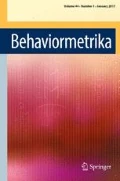Abstract
In this paper, we have suggested a weighted unbiased estimator based on mixed randomized response model. Some unbiased estimators are generated from the proposed weighted estimator. The variance of the proposed weighted estimator is obtained and relevant condition is obtained in which the proposed weighted estimator is superior to Singh and Tarray (Sociol Methods Res 44(4):706–722, 2014) estimator. It is interesting to mention that we have investigated an estimator \( \hat{\pi }_{{{\text{HS}}\left( 1 \right)}} \) which is the member of the suggested weighted estimator \( \hat{\pi }_{\text{HS}} \) provide better efficiency than the Singh and Tarray’s (2014) estimator \( \hat{\pi }_{\text{h}} \) and close to the optimum estimator \( \hat{\pi }_{\text{HS}}^{{\left( {\text{o}} \right)}} \). Thus, the estimator \( \hat{\pi }_{{{\text{HS}}\left( 1 \right)}} \) is an alternative to optimum estimator \( \hat{\pi }_{\text{HS}}^{{\left( {\text{o}} \right)}} \). The study is further extended in case of stratified random sampling.
Similar content being viewed by others
References
Chang HJ, Huang KC (2001) Estimation of proportion and sensitivity of a qualitative character. Mertika 53:269–280
Chang HJ, Wang CL, Huang KC (2004a) Using randomized response to estimate the proportion and truthful reporting probability in a dichotomous finite population. J Appl Stat 53:269–280
Chang HJ, Wang CL, Huang KC (2004b) On estimating the proportion of a qualitative sensitive character using randomized response sampling. Qual Quant 38:675–680
Chaudhuri A, Mukerjee R (1987) Randomized response technique: a review. Stat Neerl 41:27–44
Chaudhuri A, Mukerjee R (1988) Randomized response. Statistics: textbooks and monographs, vol 85. Marcel Dekker Inc, New York
Christofides TC (2003) A generalized randomized response technique. Metrika 57(195):200
Fox JA, Tracy PE (1986) Randomized response: a method of sensitive surveys. Sage, Newbury Park
Hedayat AS, Sinha BK (1991) Design and inference in finite population sampling. Wiley, New York
Hong K, Yum J, Lee H (1994) A stratified randomized response technique. Korean J Appl Stat 7:141–147
Huang KC (2004) A survey technique for estimating the proportion and sensitivity in a dichotomous finite population. Stat Neerlandica 58:75–82
Kim JM, Elam ME (2005) A two-stage stratified Warner’s randomized response model using optimal allocation. Metrika 61:1–7
Kim JM, Warde WD (2005) A mixed randomized response model. J Stat Plan Inference 133:211–221
Mahmood M, Singh S, Horn S (1998) On the confidentiality guaranteed under randomized response sampling: a comparison with several new techniques. Biom J 40(2):237–242
Mangat NS (1994) An improved randomized response strategy. J R Stat Soc Ser B 56:93–95
Mangat NS, Singh R (1990) An alternative randomized response procedure. Biometrika 77(2):439–442
Mangat NS, Singh R, Singh S (1997) Violation of respondent’s privacy in moors model—its rectification through a random group strategy response model. Commun Stat Theory Methods 3:243–255
Moors JJA (1997) A critical evaluation of Mangat’s two-step procedure in randomized response. Discussion paper at Center for Economic Research. Tilburg University, Tilburg
Singh HP, Tarray TA (2012) A stratified unknown repeated trials in randomized response sampling. Commun Stat Appl Methods 19(6):751–759
Singh HP, Tarray TA (2014) An efficient alternative mixed randomized response procedure. Sociol Methods Res 44(4):706–722
Singh S, Singh R, Mangat NS (2000) Some alternative strategies to Moor’s model in randomized response model. J Stat Plan Inference 83:243–255
Tracy DS, Mangat NS (1996) Some developments in randomized response sampling during the last decade—a follow up of review by Chaudhuri and Mukherjee. J Appl Stat Sci 4:147–158
Warner SL (1965) Randomized response: a survey technique for eliminating evasive answer bias. J Am Stat Assoc 60:63–69
Author information
Authors and Affiliations
Corresponding author
Additional information
Communicated by Haruhiko Ogasawara.
About this article
Cite this article
Singh, H.P., Gorey, S.M. Use of weights in mixed randomized response model. Behaviormetrika 45, 225–259 (2018). https://doi.org/10.1007/s41237-018-0049-9
Received:
Accepted:
Published:
Issue Date:
DOI: https://doi.org/10.1007/s41237-018-0049-9



